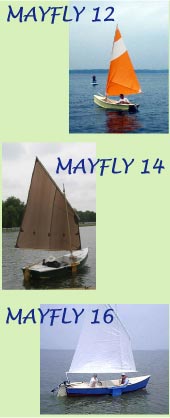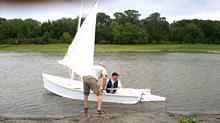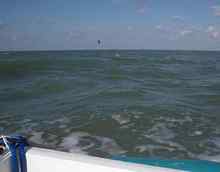
 Custom Search
|
|
| sails |
| plans |
| epoxy |
| rope/line |
| hardware |
| canoe/Kayak |
| sailmaking |
| materials |
| models |
| media |
| tools |
| gear |
 |
 |
| join |
| home |
| indexes |
| classifieds |
| calendar |
| archives |
| about |
| links |
| Join Duckworks Get free newsletter Comment on articles CLICK HERE |
|
|
| Gamaray, a Mayfly 14, Does the Texas200 - PT 2 |
by Chuck Pierce - Beaumont, Texas - USA |
Michalak Mayfly: Part 1 - The Build The next morning I loaded the boat up and headed to Magnolia Beach to meet my friend Stan Roberts. Stan had recently finished his Michalak Family Skiff, and we planned to spend the weekend sailing, camping, and wringing my new boat out. When I arrived, Stan and his wife Bride were already there and we decided that going out on Matagorda Bay to test an untried boat in the 20 knot winds and 3 foot waves might not be the best thing to do. We headed to Lake Texana instead. The water level at the lake was down to the point that the boat ramps were all unusable, so Stan had no way of getting his boat into the water, but he (good guy that he is) gamely agreed to stay overnight anyway so that we could play with Gamaray's rig. I had never rigged or sailed a balanced lug, so all I knew was what I had read, and there is not a lot of information on balanced lugs out there. That is changing as small boat designers like Jim Michalak, Michael Storer, and John Welsford continue to champion the virtues of this rig. Jim has some great info in his March 2011 newsletter found here. Mik Storer’s excellent website has a great section on balanced lug rigs as they pertain to his Goat Island Skiff design. If you are interested in this rig be sure and check these out! Stan helped pull the boat across the grass from our campsite to the nearby slough and after rowing it for a while, we installed the mast and got the sail up. He pointed out some issues to be addressed when I got home and made some suggestions about hardware placement, then I put both reefs in (winds were still 20 knots or so) and off we went.
She sailed downwind just fine, but would not sail closer than 80 degrees or so upwind. This was, umm, a problem. I was having trouble keeping the leeboard down in the shallow, narrow slough, and the main body of the lake was very rough so after a while we gave up and set up camp. Bride brought us a nice supper when she returned from town and we stayed up and talked about boats, politics, and assorted other random subjects until late. Back in Beaumont, I made the changes Stan had suggested and went down to one of the 30 acre retention ponds off the Neches River to do further testing. The winds were lighter and I started out with no reefs in the sail. It was like sailing a different boat-she tacked through 100 degrees and was reasonably fast to boot, especially downwind. Then I reefed her down, and the windward performance again went all to hell. I played with the rig as much as I could, but could not get her to go upwind with both reefs in. That was an important issue to work through if this were going to be my Texas200 boat. On the 2011 route there were going to be a couple of days that required a fair amount of upwind work, and I knew from past experience that we might have both reefs tucked in for a good part of the event. Not going to windward with both reefs meant not doing the 200 in this boat. That evening when I got home I got on the Duckworks Yahoo forum and asked for advice. I got some great comments about comparing full versus reefed sail shape, outhaul angles when the sail was reefed, and halyard location. The next evening after work I raised the sail and compared the shape with and without the reefs - sure enough the sail reefed did not have the same shape it had with the full sail up, and no wonder - I had made the darts too deep by a factor of 2! When I remade them, that brought things more in line. I moved the slab reefing cheekblock aft and that helped the reefed shape as well. I also abandoned the halyard chock location on the yard. Stan had recommended a loop of line doubled through itself around the boom as a place to attach the downhaul so that it was moveable for different sail configurations. I did the same thing with the yard and moved the halyard attachment point towards the bow 8 or 10 inches (moving the sail back by the same amount). I had planned on testing the changes on Wednesday and Thursday after work, but we had our first rain in a couple of months, and thunderstorms came through the area one after another for most of both days. So much for that. Late Thursday night (May 12th, the last day to get a shuttle ticket) I took a big leap of faith and signed up for the Texas200 shuttle. Saturday morning dawned clear and windy, and I headed out for the Pleasure Island Marina on Lake Sabine to see what effect the changes had on Gamaray's performance. What a difference! The mods made the boat point better in all sail configurations. She tacked through 90 degrees with the full sail up and 100 degrees even with both reefs in. After a 4 hour sail using every reef configuration, the reservations I'd had the previous week about doing the Texas200 in this boat were gone. She went wherever I wanted her to, even double reefed, in winds of 12 knots gusting to 16 or so. Now that I was confident in the boat, the prep for the trip could start for real. When I got home, I got all of the gear and supplies together and weighed everything. It looked like we would be about 90 pounds overweight at the start of the trip, but I did the math and determined that because of the flat bottom, the extra weight meant only about 1 inch of extra draft, not that big a deal. I loaded her up, and for the next 3 weeks I sailed her every chance I got in the 15-20 knot winds and 2-3 foot waves that Lake Sabine provides us with every afternoon this time of year. I capsized her empty. I capsized her fully loaded. I practiced putting in and taking out reefs on the water. The extra weight did cause the stern to drag a bit and that probably cost us half a knot or so, but I did not mind a bit. My goal for the 200 was to make all of the camps and get to the end. I didn't care about speed as long as we were fast enough to get to camp by dark everyday. We made it to the White Sands Motel/Marina in Port Isabel about 3pm on the afternoon of Saturday, June 11th. Texas200 boats were everywhere-on trailers, in the backs of trucks, and in the slips. I ran into quite a few folks who we had sailed with in previous years and spent some time catching up and helping launch boats before we pulled Gamaray out of the back of the truck and put her into the water. There were some interesting boats-Dan Gross had brought his new Weekender, John Goodman was there with his beautiful Goat Island Skiff and some guy with a funny accent, and Mike Monies showed up with the famous Red Scamp. Stan was there with his wife and son (and his Family Skiff, which was actually in the water!) and generously offered space in his slip for the boat and a couch in an air conditioned room for me. The shuttle run up to Seadrift took all day Sunday, but it was a nice ride back in the company of some great sailors and storytellers, although some of us took the opportunity to catch up on sleep. Bedtime Sunday evening came fairly early in spite of naps and most of us were up the next morning by 6 am. We pulled out of Port Isabel Monday about 6:30am. Winds were light as we turned into the ICW and headed northwest. When there are no big waves pushing her around, Gamaray is easy to balance and you can steer her easily by just leaning opposite of the direction you want her to turn, so I rigged my self-steering bungie and sat in the center of the boat drinking coffee. After coffee and a Clif bar, I used the time to get things organized in the cockpit and get the chart for the day set up. That morning, we passed a few boats and got passed by more than a few, but as the day wore on, I saw fewer and fewer boats. By Miller passed us about noon in his Sea Pearl, moving at a good clip. His was the last boat we saw until we turned into the Port Mansfield Channel several hours later. By 2pm the wind had picked up to its customary 15 knots and we anchored briefly so that I could tuck both reefs in, figuring correctly that as the afternoon went on the winds would continue to build. At about 3pm we turned into the wind and began the long series of tacks up the Port Mansfield channel to the first camp. In addition to the chop the wind was kicking up, there was a pretty good swell off the Gulf coming down the channel, so after each tack I would bail several gallons before having to drop the bailer and tack again. A couple of boats passed us going the other way-the captain of one of them said that they were heading to Port Mansfield for the night and would see us at the second camp. A little after 4pm, I saw some boats pulled over to a spoil island off the starboard bow. I could see Travis Votaw's Princess 22 Pilgrim, Jubilee, Kevin Nicolin's Core Sound, and a few others. As I got closer I noticed that there were tents set up. Apparently some of the fleet had decided to pull in there having had enough of the long slog to windward. By this time the swell was up to about 3 feet and getting bigger. A quarter mile past the camp, it had increased to the point that I was having trouble getting Gamaray through her tacks, and keeping up with the bailing was getting harder and harder. It was 4:30pm, and we were only a little over halfway up the channel to the designated camp at the jetties, making 6pm a best case arrival time. I thought it over for a few seconds, and the boat and I came to an agreement almost instantly. We whipped around and headed back downwind towards the camp we had passed earlier. Shortly after we pulled in, the crew of Pilgrim headed her back down the channel towards Port Mansfield hoping to find some help with their stuck centerboard. Gir, with John Goodman and Mik Storer aboard pulled in about the same time we did. Dave Ware, Mike Monies, By, Kevin, John and Mik, and the guys in the Herreshoff 12 1/2 footer (I don't think that I had the chance to meet them-beautiful boat, though) all stayed the night. The picture above was taken about 6:30pm-notice the whitecaps in the channel even though the winds had abated somewhat. Notice as well that the tide was out at sunset. The next morning at dawn, the tide had come back in. I have heard it said that the tides down here, only being 6 to 12 inches, are not worth worrying about. This is a great illustration of why that is not necessarily true. If it had been high tide instead of low tide that evening, our boats would have been fifty or sixty feet from the water at low tide the next morning. As it happened Gamaray was in a whopping 8 inches floating freely. I pulled her in and loaded up then pulled out as Chuck and Sandra Leinweber sailed by in their Michalak Caprice, Pearl. They sped out of sight before we made our turn into the ICW, but I could see some of the other Texas200 boats coming out of Port Mansfield. The winds picked up by 9am - much earlier that morning than on the previous day, and with the winds came the steep chop that the shallow waters of the Laguna Madre and the bays down here are known for.
A couple of hours later the rudder started feeling funny, so I pulled out of the ICW, threw out the anchor and investigated. Good thing I did! The lower pintle was completely off the rudder, but fortunately was still in its gudgeon. The screws were nowhere to be found, but fortunately I had the "hardware store" with me. Gamaray's aft storage compartment held a pretty complete set of tools including a handsaw, drill and bits - as well as several bins filled with tape, nuts, bolts, washers, screws, epoxy, spare lines, and a spare leeboard that was already marked so that it could be cut down to function as a spare rudder blade. About 70 pounds worth of stuff, and I would not have left any of it behind. I pulled out some oversized screws and the drill and did a temporary repair as a bunch of the boats from our camp and from the jetties camp zoomed past. As they did, I experienced one of the great things about the type of person that this event draws - EVERY boat that passed us while I worked on the rudder asked three things- did I need any help, did I need any parts, and did I need any tools. Within 15 minutes we were on our way, and half an hour later we were in the Land Cut and catching up with Kevin Allison and Jon Kowitz in the two Geese that had passed us while we repaired the rudder. The three of us arrived at the second camp together after a nice smooth sail (race) in the Land Cut. Funny how we all started paying attention to sail trim once we were closer together! As I set up camp, the winds were so high that some of the tents were blowing over (mine was one) and we had to move a couple of them up into an area that was partially sheltered from the wind by some vegetation. This was the first camp that pretty much everyone made, so we were all together for the first time of the trip. It was here that we in the smaller boats started to find our rhythm. Make camp, set up the tent, unload the boat, rest in the shade of the tent until it cools down a bit (usually 6 or 6:30pm), then visit until dark (after 8:30pm this time of year), in bed by 9pm or so. Up at first light, break camp, load the boat, sail all day. Repeat as needed to get to the end!
|


